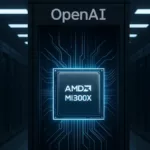HTC’s recent launch of its long-awaited Evo 4G smartphone has helped to accelerate the fast-paced Android revolution with a number of high-end features, including HDMI connectivity, WiFi hotspot capabilities, a 1 Ghz Snapdragon processor and a 720P HD video camera.
Indeed, as AMD corporate VP Pat Moorehead noted in a recent blog post, mobile enthusiasts are “finally getting” capabilities on their phones that were historically only available on a PC.

“Technologists are impressed with the bleeding edge [smartphone] technology [moving] at break neck speed. The new HTC EVO 4G – which exemplifies just this – brings some amazing features to users today. [However], I am more interested about what it signals for tomorrow,” wrote Moorehead.
“[For example], real-time video communications will finally go mainstream. I know, we have heard this since 1970 and there have been a thousand failures since then. [But] it’s different now, [because] the quality is better, it’s close to ‘free,’ tech giants are behind it and there will be billions of capable end points. [And] getting Apple behind it is huge with iPhone 4. They got it as ‘right’ as you can get it from a consumer’s point of view. All we need now is inter-compatibility between disparate systems.”
According to Moorehead, it will soon be difficult to purchase a smartphone that does not include a “decent quality,” on-board 1080P video camera.
“As with camera phones today, smartphone buyers will be popping off high quality videos and either loading snippets to the cloud or transferring the full video to their home PC.
“As for those longer videos on the PC, users will want to cut, snip, improve and ultimately be able to play on any device via transcoding. [So] yes, the PC will still matter in the future.”
Moorehead also noted that smartphone bandwidth will continue to be costly and rationed, which would “ultimately” emphasize the continued importance of client-side computing performance.
“While major phone, PC, and server technologies get major overhauls every five years, wireless overhauls take around ten years. I don’t expect 4G to be much different. In the US, 3G networks are busting at the seams and carriers are beginning to eliminate unlimited rate plans and charge a ton for tethering.
“As such, expensive and slow bandwidth with high user demand will drive the need for better CODECs (COmpression-DECompression) to pump higher density content through a small pipe then be displayed on the other end of the pipe. CPUs and GPUs do this well and combined APUs will do it do it even better.”






